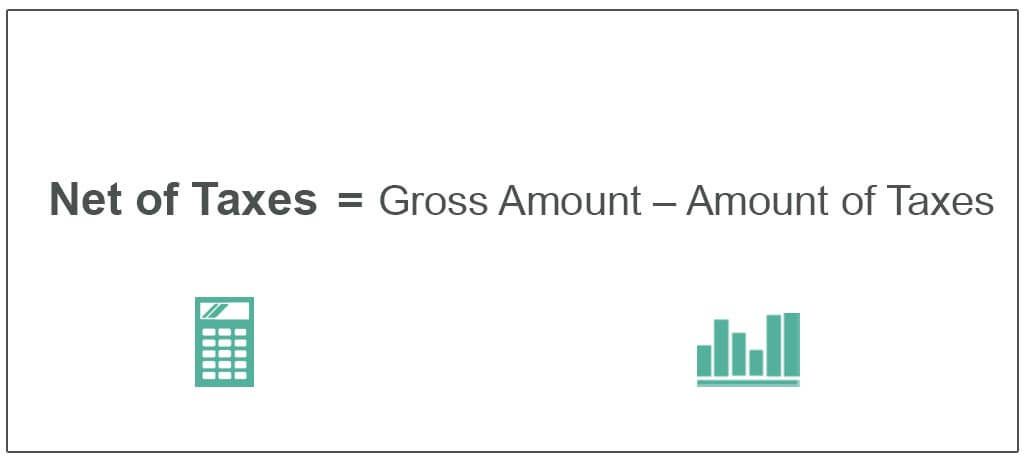Table Of Contents
Net of Taxes Meaning
Net of taxes refers to the final amount left after the deduction of taxes. Since the payment of taxes is the legal & statutory obligation for any business which cannot be avoided, the analysis of before and after-tax values requires serious consideration in strategizing the major investment and operating decisions of the company.
Net of Taxes Formula
Net of Taxes = Gross Amount – Amount of Taxes

The amount net of tax can be calculated by subtracting the amount of taxes from the gross value.
Example of Net of Taxes
For Example, the total Income of ABC Inc. for the year ending 2019 was $ 1,000.00. However, ABC Inc. is liable to pay the U.S. federal corporate income tax at the applicable rate for the year 2019, which is 21%. The Net Income after taxes of the company is calculated as below:
Calculation of Net Income after Taxes

- =$1000.00-$210.00
- =$790.00
Now, it is vital to understand the significance of gross income and net income. Gross Income of U.S. $ 1,000.00 represents the total earning of ABC Inc. after considering all the manufacturing, general, and selling expenses. However, the company can neither keep the entire gross income as its retaining earnings nor declare any dividend payouts on gross income. The company, by law, is under obligation to honor its taxes. Hence, the company can only declare dividend on its net disposable income after taxes of U.S. $ 790.00
Significance of Net of Taxes Values in Various Business Events
The importance of considering Gross and Net values can affect various business decisions can be observed in the following business scenarios.
#1 - Sales of Goods / Services
Generally, all the goods and services offered by the businesses involve the levy of sales tax on it as mandated by the tax laws. Sales tax is an indirect tax on the income of the end-user, i.e., the burden of sales tax is generally passed to the customers by the companies by adding the tax amount in the selling price of their goods and/or services.
Example
Let us suppose, ABC Inc. sells artistic pen sets at the selling price (inclusive of sales tax @ 20%) of U.S. $ 120.00 per unit. John bought 10 pen sets and paid the U.S. $ 1,200.00 to the company.
Since the selling price was inclusive of sales tax, the selling price of a pen set is the U.S. $ 100, and the U.S. $ 20/set is added as the amount of sales tax. Due to which ABC Inc. is liable to pay the amount of sales tax collected by the company to the Government. The company is required to separately show the sales tax amount in its financial statements as:
Calculation of Net Sales

- =$1200 - $200
- =$1000
#2 - Sales of Assets and Investments
Whenever a company makes the sale of its assets such as furniture, machinery, etc., or any investment like bonds, shares, or sale of any of its business, any profit earned from such sale is known as capital gains. Since the capital gain is an income for the seller, it attracts levy of income tax on such gain amount.
Example
For instance, ABC Inc. holds 25000 common stocks of Z Inc. The company acquired the stocks 5 years ago at a price of U.S. $ 20 per share. At present, the shares of ZInc. are trading at the U.S. $ 80 per share. The company decides to sell half of its investment at the current price of U.S. $ 80 per share. The value of capital gains can be derived as:
Calculation of Capital Gains

- =$1000000 - $250000
- =$750000
Assuming the capital gains are taxable at a flat rate of 10%. The Net earnings on the sale of investment will be the number of capital gains minus tax on the capital gain.
However, to save the amount of capital gains, the company can reinvest it for a certain lock-in period as defined in tax laws. Such reinvestment can allow the exemption of tax on the amount of capital gains reinvested by the company.
#3 - Taxes on Income
If a company earns a profit, it cannot be considered as final disposable income. Before appropriating the total income into retained earnings and dividend payouts, the company has to pay income tax on the total profit made during the year by the company. The net income after deducting the amount of tax can only be considered as disposable income.
Thus, to maintain growth in the profitability trends, the company is required to forecast its before and after-tax earnings with due diligence and care.
Even in the case of individuals, the amount of salary they receive at the end of every month is the net take-home pay after deducting taxes and other contributions. The amount of tax can be reduced by making regular contributions to 401K payments. Thus, it is important for individuals as well to keep a check on their before and after-tax payouts in order to properly plan for payment of taxes.
Conclusion
Net of tax amount is the amount left after making adjustments for tax. Since the key objective of any business is to maximize the wealth, the understanding of gross and net values can help the business entities to strategies their pricing policies, investment decisions, dividend decisions, through financial tax planning.
